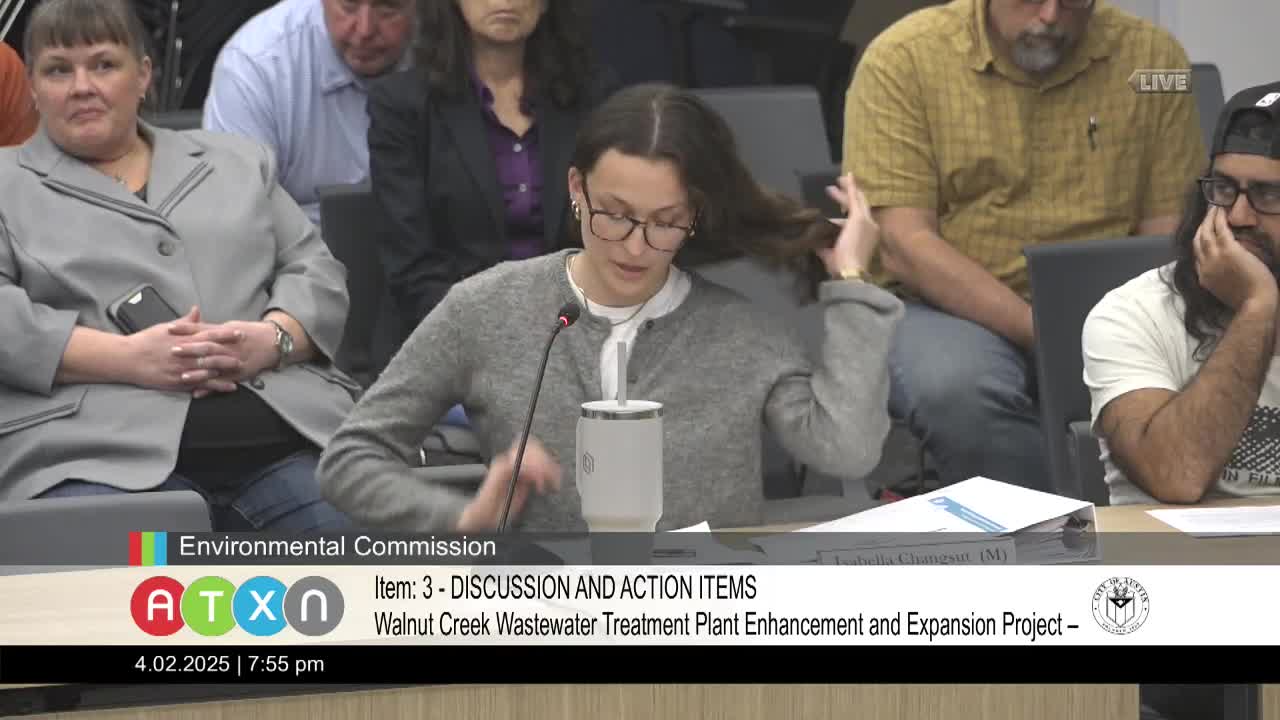Austin Water plans reclaimed water expansion amid wastewater treatment upgrades
April 02, 2025 | Austin, Travis County, Texas
This article was created by AI summarizing key points discussed. AI makes mistakes, so for full details and context, please refer to the video of the full meeting. Please report any errors so we can fix them. Report an error »

In a recent meeting of the Austin Environmental Commission, city officials engaged in a robust discussion about the future of water management and infrastructure in the rapidly growing city. As the sun set over the Texas skyline, the urgency of sustainable practices echoed through the chambers, reflecting the community's pressing need for innovative solutions to water usage and treatment.
One of the central topics was the allocation of budget resources towards expanding recycled water usage. A commissioner raised concerns that current funding seemed directed towards temporary fixes rather than long-term sustainable solutions. In response, city representatives emphasized their commitment to a comprehensive capital planning process that balances the need for renewing aging infrastructure with investments in new technologies, such as the Walnut Creek Wastewater Plant. This facility is seen as foundational for ensuring high-quality wastewater treatment as Austin's population continues to grow.
The conversation also touched on the energy demands of wastewater treatment. A commissioner highlighted that treatment plants consume a significant portion of global energy, raising questions about whether the expansion of facilities would lead to increased energy consumption. City officials acknowledged that while the expansion would likely require more energy, they are committed to using the most efficient technologies available. They are also exploring strategies to manage energy use during peak times, working closely with Austin Energy to optimize operations.
As the meeting progressed, the importance of self-regulation and adherence to environmental standards was underscored. Officials reassured attendees that even in the absence of regulatory oversight, Austin Water would continue to prioritize public health and environmental protection, adhering to best practices in the industry.
The discussions at the Environmental Commission meeting reflect a city grappling with the challenges of growth while striving to implement sustainable practices. As Austin looks to the future, the commitment to innovative water management and energy efficiency will be crucial in navigating the complexities of urban expansion and environmental stewardship. The outcomes of these discussions will not only shape the city's infrastructure but also set a precedent for how urban areas can responsibly manage their resources in an era of climate change.
One of the central topics was the allocation of budget resources towards expanding recycled water usage. A commissioner raised concerns that current funding seemed directed towards temporary fixes rather than long-term sustainable solutions. In response, city representatives emphasized their commitment to a comprehensive capital planning process that balances the need for renewing aging infrastructure with investments in new technologies, such as the Walnut Creek Wastewater Plant. This facility is seen as foundational for ensuring high-quality wastewater treatment as Austin's population continues to grow.
The conversation also touched on the energy demands of wastewater treatment. A commissioner highlighted that treatment plants consume a significant portion of global energy, raising questions about whether the expansion of facilities would lead to increased energy consumption. City officials acknowledged that while the expansion would likely require more energy, they are committed to using the most efficient technologies available. They are also exploring strategies to manage energy use during peak times, working closely with Austin Energy to optimize operations.
As the meeting progressed, the importance of self-regulation and adherence to environmental standards was underscored. Officials reassured attendees that even in the absence of regulatory oversight, Austin Water would continue to prioritize public health and environmental protection, adhering to best practices in the industry.
The discussions at the Environmental Commission meeting reflect a city grappling with the challenges of growth while striving to implement sustainable practices. As Austin looks to the future, the commitment to innovative water management and energy efficiency will be crucial in navigating the complexities of urban expansion and environmental stewardship. The outcomes of these discussions will not only shape the city's infrastructure but also set a precedent for how urban areas can responsibly manage their resources in an era of climate change.
View full meeting
This article is based on a recent meeting—watch the full video and explore the complete transcript for deeper insights into the discussion.
View full meeting
